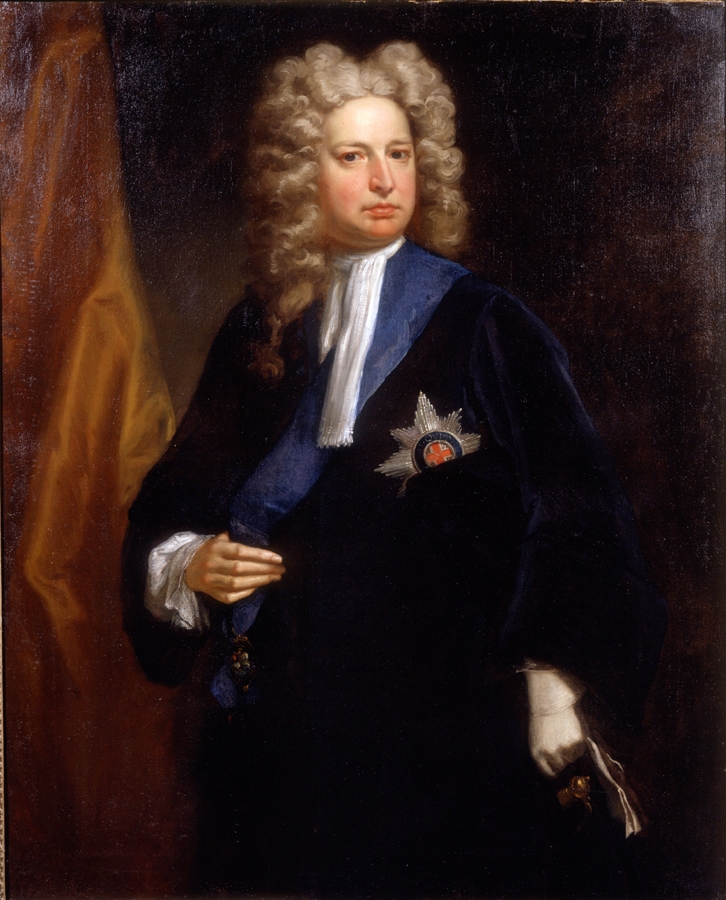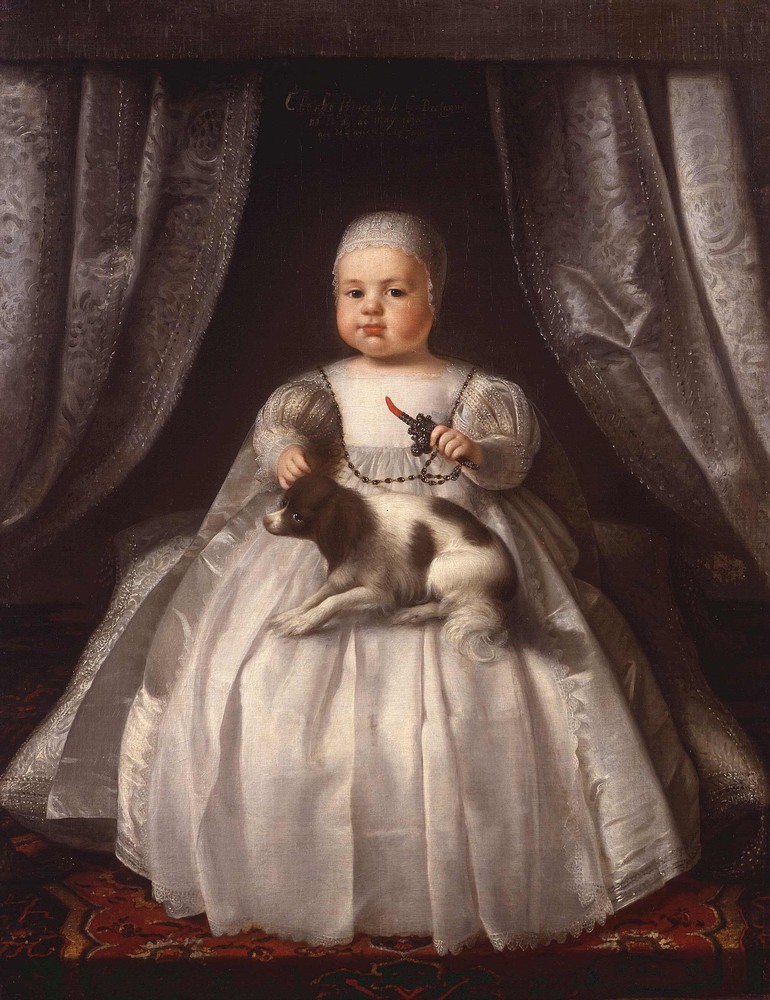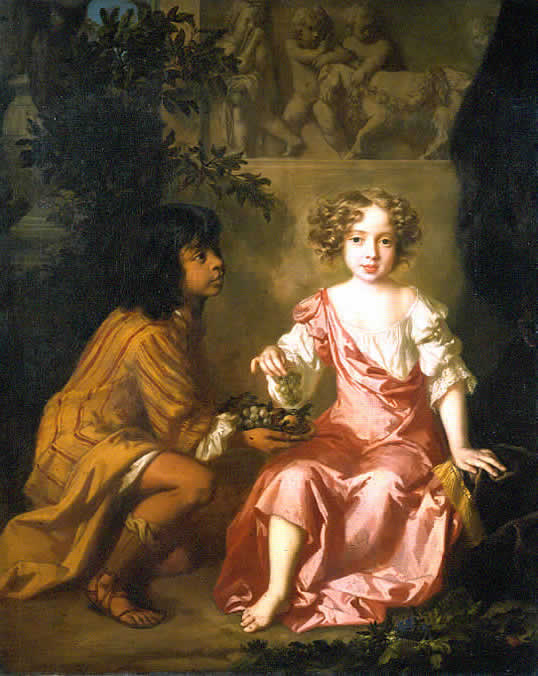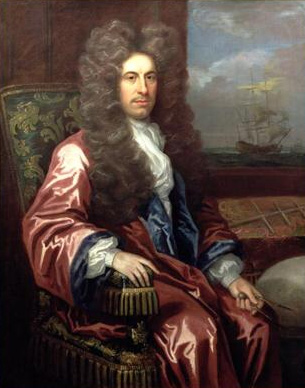|
Benedict Calvert, 4th Baron Baltimore
Benedict Leonard Calvert, 4th Baron Baltimore (21 March 1679 – 16 April 1715) was an English nobleman and politician. He was the second son of Charles Calvert, 3rd Baron Baltimore (1637–1715) by Jane Lowe, and became his father's heir upon the death of his elder brother Cecil in 1681. The 3rd Lord Baltimore was a devout Roman Catholic, and had lost his title to the Province of Maryland shortly after the events of the Glorious Revolution in 1688, when the Protestant monarchs William III and Mary II acceded to the British throne. Benedict Calvert made strenuous attempts to have his family's title to Maryland restored by renouncing Roman Catholicism and joining the Church of England. In February 1715 Benedict became the 4th Baron Baltimore upon the death of his father, and he immediately petitioned King George I for the restoration of Maryland to his control. However, before the King could rule on the petition, Baltimore died aged 36, outliving his father by just two months. ... [...More Info...] [...Related Items...] OR: [Wikipedia] [Google] [Baidu] |
The Right Honourable
''The Right Honourable'' (abbreviation: ''Rt Hon.'' or variations) is an honorific Style (form of address), style traditionally applied to certain persons and collective bodies in the United Kingdom, the former British Empire and the Commonwealth of Nations. The term is predominantly used today as a style associated with the holding of certain senior public offices in the United Kingdom, Canada, New Zealand, and to a lesser extent, Australia. ''Right'' in this context is an adverb meaning 'very' or 'fully'. Grammatically, ''The Right Honourable'' is an adjectival phrase which gives information about a person. As such, it is not considered correct to apply it in direct address, nor to use it on its own as a title in place of a name; but rather it is used in the Grammatical person, third person along with a name or noun to be modified. ''Right'' may be abbreviated to ''Rt'', and ''Honourable'' to ''Hon.'', or both. ''The'' is sometimes dropped in written abbreviated form, but is al ... [...More Info...] [...Related Items...] OR: [Wikipedia] [Google] [Baidu] |
Gentleman Of The Bedchamber
Gentleman of the Bedchamber was a title in the royal household of the Kingdom of England from the 11th century, later used also in the Kingdom of Great Britain. A Lord of the Bedchamber was a courtier in the Royal Household; the term being first used in 1718. The duties of the Lords and Gentleman of the Bedchamber originally consisted of assisting the monarch with dressing, waiting on him when he ate, guarding access to his bedchamber and closet and providing companionship. Such functions became less important over time, but provided proximity to the monarch; the holders were thus trusted confidants and often extremely powerful. The offices were in the gift of The Crown and were originally sworn by Royal Warrant directed to the Lord Chamberlain. This is an ''incomplete'' list of noblemen who have served as Lord of the Bedchamber or Gentleman of the Bedchamber: Description and functions There were always several holders of the office, who were invariably gentlemen and almost ... [...More Info...] [...Related Items...] OR: [Wikipedia] [Google] [Baidu] |
Anglicanism
Anglicanism is a Western Christian tradition that has developed from the practices, liturgy, and identity of the Church of England following the English Reformation, in the context of the Protestant Reformation in Europe. It is one of the largest branches of Christianity, with around 110 million adherents worldwide . Adherents of Anglicanism are called ''Anglicans''; they are also called ''Episcopalians'' in some countries. The majority of Anglicans are members of national or regional ecclesiastical provinces of the international Anglican Communion, which forms the third-largest Christian communion in the world, after the Roman Catholic Church and the Eastern Orthodox Church. These provinces are in full communion with the See of Canterbury and thus with the Archbishop of Canterbury, whom the communion refers to as its ''primus inter pares'' (Latin, 'first among equals'). The Archbishop calls the decennial Lambeth Conference, chairs the meeting of primates, and is th ... [...More Info...] [...Related Items...] OR: [Wikipedia] [Google] [Baidu] |
Robert Harley, 1st Earl Of Oxford And Earl Mortimer
Robert Harley, 1st Earl of Oxford and Earl Mortimer, KG PC FRS (5 December 1661 – 21 May 1724) was an English statesman and peer of the late Stuart and early Georgian periods. He began his career as a Whig, before defecting to a new Tory ministry. He was raised to the peerage of Great Britain as an earl in 1711. Between 1711 and 1714 he served as Lord High Treasurer, effectively Queen Anne's chief minister. He has been called a ''prime minister'', although it is generally accepted that the de facto first minister to be a prime minister was Robert Walpole in 1721. The central achievement of Harley's government was the negotiation of the Treaty of Utrecht with France in 1713, which brought an end to twelve years of English and Scottish involvement in the War of the Spanish Succession. In 1714 Harley fell from favour following the accession of the first monarch of the House of Hanover, George I, and was for a time imprisoned in the Tower of London by his political enem ... [...More Info...] [...Related Items...] OR: [Wikipedia] [Google] [Baidu] |
Charles Calvert 3rd Baron Baltimore
Charles is a masculine given name predominantly found in English and French speaking countries. It is from the French form ''Charles'' of the Proto-Germanic name (in runic alphabet) or ''*karilaz'' (in Latin alphabet), whose meaning was "free man". The Old English descendant of this word was '' Ċearl'' or ''Ċeorl'', as the name of King Cearl of Mercia, that disappeared after the Norman conquest of England. The name was notably borne by Charlemagne (Charles the Great), and was at the time Latinized as ''Karolus'' (as in ''Vita Karoli Magni''), later also as '' Carolus''. Some Germanic languages, for example Dutch and German, have retained the word in two separate senses. In the particular case of Dutch, ''Karel'' refers to the given name, whereas the noun ''kerel'' means "a bloke, fellow, man". Etymology The name's etymology is a Common Germanic noun ''*karilaz'' meaning "free man", which survives in English as churl (< Old English ''ċeorl''), which developed its ... [...More Info...] [...Related Items...] OR: [Wikipedia] [Google] [Baidu] |
Coat Of Arms Of Cecil Calvert, Baron Baltimore
A coat typically is an outer garment for the upper body as worn by either gender for warmth or fashion. Coats typically have long sleeves and are open down the front and closing by means of buttons, zippers, hook-and-loop fasteners, toggles, a belt, or a combination of some of these. Other possible features include collars, shoulder straps and hoods. Etymology ''Coat'' is one of the earliest clothing category words in English, attested as far back as the early Middle Ages. (''See also'' Clothing terminology.) The Oxford English Dictionary traces ''coat'' in its modern meaning to c. 1300, when it was written ''cote'' or ''cotte''. The word coat stems from Old French and then Latin ''cottus.'' It originates from the Proto-Indo-European word for woolen clothes. An early use of ''coat'' in English is coat of mail (chainmail), a tunic-like garment of metal rings, usually knee- or mid-calf length. History The origins of the Western-style coat can be traced to the sleeved, ... [...More Info...] [...Related Items...] OR: [Wikipedia] [Google] [Baidu] |
Charles II Of England
Charles II (29 May 1630 – 6 February 1685) was King of Scotland from 1649 until 1651, and King of England, Scotland and Ireland from the 1660 Restoration of the monarchy until his death in 1685. Charles II was the eldest surviving child of Charles I of England, Scotland and Ireland and Henrietta Maria of France. After Charles I's execution at Whitehall on 30 January 1649, at the climax of the English Civil War, the Parliament of Scotland proclaimed Charles II king on 5 February 1649. But England entered the period known as the English Interregnum or the English Commonwealth, and the country was a de facto republic led by Oliver Cromwell. Cromwell defeated Charles II at the Battle of Worcester on 3 September 1651, and Charles fled to mainland Europe. Cromwell became virtual dictator of England, Scotland and Ireland. Charles spent the next nine years in exile in France, the Dutch Republic and the Spanish Netherlands. The political crisis that followed Cromwell's deat ... [...More Info...] [...Related Items...] OR: [Wikipedia] [Google] [Baidu] |
Charlotte Lee, Countess Of Lichfield
Charlotte Lee, Countess of Lichfield (5 September 1664 – 17 February 1718), formerly Lady Charlotte Fitzroy, was the illegitimate daughter of King Charles II of England by one of his best known mistresses, Barbara Villiers, 1st Duchess of Cleveland. Known for her beauty, Charlotte was married at age 12 to her husband, Edward Henry Lee, 1st Earl of Lichfield, with whom she had a large family. Early life Charlotte Lee was born Charlotte Fitzroy, on 5 September 1664,Andrews, p.216 the fourth child and second daughter of Barbara Palmer, Countess of Castlemaine, the only child of the Royalist commander William Villiers, 2nd Viscount Grandison. She was placed in the care of a governess in Berkshire House. Charlotte Fitzroy's mother had separated from her husband Roger Palmer, 1st Earl of Castlemaine, but was still married to him. Castlemaine did not father any of his wife's children; Charlotte and her siblings were the illegitimate offspring of their mother's royal l ... [...More Info...] [...Related Items...] OR: [Wikipedia] [Google] [Baidu] |
Edward Lee, 1st Earl Of Lichfield
Edward Henry Lee, 1st Earl of Lichfield (4 February 1663 – 14 July 1716) was an English peer, the son of a baronet, who at 14 years of age married one of the illegitimate daughters of King Charles II, Charlotte Lee, prior to which he was made Earl of Lichfield. They had a large family; Lady Lichfield bore him 18 children. He was a staunch Tory and followed James II to Rochester, Kent after the king's escape from Whitehall in December 1688. His subsidiary titles were Viscount Quarendon and Baron Spelsbury. Biography Early life Edward Lee was the son of Sir Francis Henry Lee, 4th Baronet of Quarendon and his wife Lady Elizabeth Pope, daughter of Thomas Pope, 2nd Earl of Downe, who was later third wife of Robert Bertie, 3rd Earl of Lindsey. His great grandfather, Henry Lee, was the cousin and heir of Henry Lee of Ditchley. His father's half-brother was the libertine-poet the Earl of Rochester In his youth, he was considered to be kind, charming, strong, intelligent as well ... [...More Info...] [...Related Items...] OR: [Wikipedia] [Google] [Baidu] |
Gray's Inn
The Honourable Society of Gray's Inn, commonly known as Gray's Inn, is one of the four Inns of Court (professional associations for barristers and judges) in London. To be called to the bar in order to practise as a barrister in England and Wales, an individual must belong to one of these inns. Located at the intersection of High Holborn and Gray's Inn Road in Central London, the Inn is a professional body and provides office and some residential accommodation for barristers. It is ruled by a governing council called "Pension," made up of the Masters of the Bench (or "benchers,") and led by the Treasurer, who is elected to serve a one-year term. The Inn is known for its gardens (the “Walks,”) which have existed since at least 1597. Gray's Inn does not claim a specific foundation date; none of the Inns of Court claims to be any older than the others. Law clerks and their apprentices have been established on the present site since at latest 1370, with records dating from ... [...More Info...] [...Related Items...] OR: [Wikipedia] [Google] [Baidu] |
Protestant Revolution (Maryland)
The Protestant Revolution of 1689, sometimes called Coode's Rebellion after one of its leaders, John Coode, took place in the Province of Maryland when Puritans, by then a substantial majority in the colony, revolted against the proprietary government led by the Roman Catholic Charles Calvert, 3rd Baron Baltimore. The rebellion followed the " Glorious Revolution" in England of 1688, which saw the Protestant monarchs William III and Mary II replace the English, Catholic monarch King James II. The Lords Baltimore lost control of their proprietary colony, and for the next 25 years, Maryland would be ruled directly by the British Crown. The Protestant Revolution also saw the effective end of Maryland's early experiments with religious toleration, as Catholicism was outlawed and Roman Catholics forbidden from holding public office. Religious toleration would not be restored in Maryland until after the American Revolution. Events leading to the Protestant Revolution of 16 ... [...More Info...] [...Related Items...] OR: [Wikipedia] [Google] [Baidu] |
Cavalry
Historically, cavalry (from the French word ''cavalerie'', itself derived from "cheval" meaning "horse") are soldiers or warriors who Horses in warfare, fight mounted on horseback. Cavalry were the most mobile of the combat arms, operating as light cavalry in the roles of reconnaissance, Screening (tactical), screening, and skirmisher, skirmishing in many armies, or as heavy cavalry for decisive shock attacks in other armies. An individual soldier in the cavalry is known by a number of designations depending on era and tactics, such as cavalryman, Equestrianism, horseman, trooper (rank), trooper, cataphract, knight, hussar, uhlan, mamluk, cuirassier, lancer, dragoon, or horse archer. The designation of ''cavalry'' was not usually given to any Military animal, military forces that used other animals for mounts, such as Camel cavalry, camels or War elephant, elephants. Infantry who moved on horseback, but dismounted to fight on foot, were known in the early 17th to the early 18t ... [...More Info...] [...Related Items...] OR: [Wikipedia] [Google] [Baidu] |
_(cropped).jpg)







